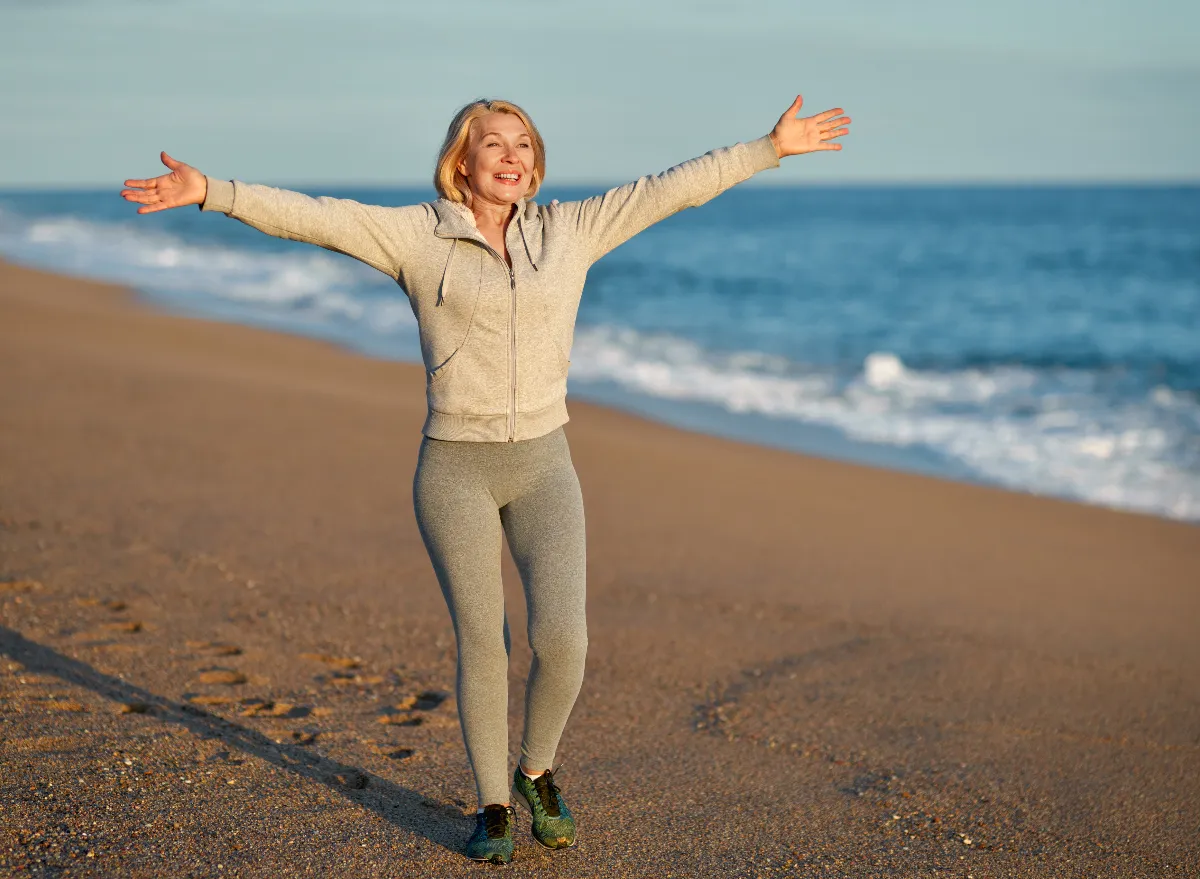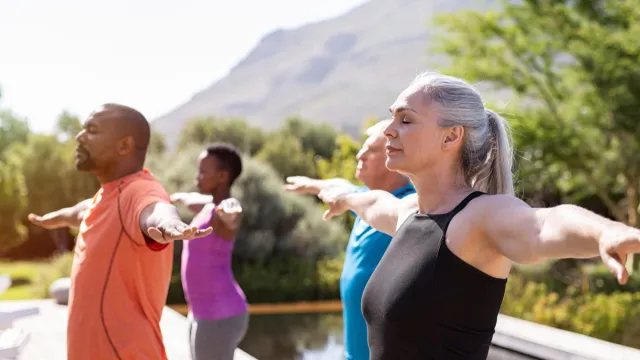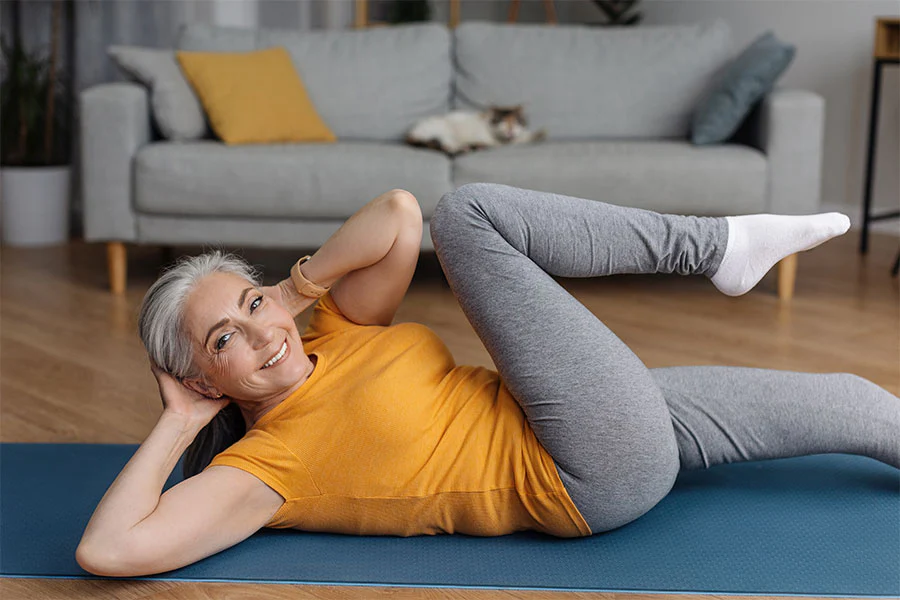As we age, it becomes increasingly important to prioritize our physical well-being. Regular exercise not only helps maintain a healthy weight, but it also strengthens our muscles and bones, improves balance and flexibility, and boosts overall energy levels. By incorporating the right exercises into your routine, you can enhance your quality of life and feel your best at any age. In this post, we’ll share the 15 best exercises specifically designed for women over 50.

Contents
15 Best Exercises for Women Over 50
Here are some of the best exercises specifically tailored for women over 50:
1. Walking:
Walking is a fantastic low-impact cardiovascular exercise that helps in maintaining heart health, reducing the risk of chronic diseases, and improving mood without straining the joints. It’s highly accessible and can be adjusted in intensity and duration to suit fitness levels.
2. Swimming:
Swimming and water aerobics offer full-body workouts, minimizing stress on the joints while improving cardiovascular health, muscle strength, and flexibility. The buoyancy of water supports the body, making it an ideal exercise for those with arthritis or those recovering from injury.
3. Cycling:
Stationary or outdoor cycling is great for enhancing leg strength and cardiovascular endurance. It’s low-impact, which makes it easier on the knees and hips, and can be enjoyed solo or in a group setting.
4. Yoga:
Yoga promotes flexibility, strength, and balance. It also aids in stress reduction and mental clarity. There are various styles of yoga, making it easy to find one that fits your needs and physical capabilities.

5. Pilates:
Pilates focuses on core strength, flexibility, and overall body conditioning. It is excellent for improving posture, balance, and muscle tone, particularly beneficial for abdominal and pelvic floor strengthening.
6. Strength Training:
Incorporating light to moderate weights or resistance bands helps maintain muscle mass, supports metabolism, strengthens bones, and reduces the risk of osteoporosis. Exercises can include squats, lunges, and arm curls, tailored to individual strength and ability.
7. Tai Chi:
This gentle form of martial arts is known for its health benefits, including improving balance, flexibility, and strength, while also reducing stress. It’s particularly beneficial for improving balance and preventing falls.
8. Dance:
Dancing is a fun way to stay active, improve cardiovascular health, and increase flexibility and balance. Whether it’s ballroom, salsa, or Zumba, dancing can be a social activity that boosts mood and cognitive function.
9. Gardening:
Gardening is a therapeutic and rewarding activity that provides moderate physical exercise. It involves various movements such as bending, lifting, and digging, which help in maintaining flexibility and muscle strength.
10. Golf:
Playing golf is a good way to enjoy the outdoors while walking and swinging a golf club, promoting cardiovascular health, muscle strength, and balance. It’s also a social sport that can reduce stress and improve mental well-being.
11. Hiking:
Hiking in nature is beneficial for cardiovascular health and muscle strength, especially in the legs and lower back. It’s also a great way to enjoy the outdoors and can be adjusted in difficulty according to fitness levels.
12. Rowing:
Rowing, either on water or a rowing machine, provides a comprehensive workout that builds upper body strength, enhances cardiovascular fitness, and improves flexibility and coordination.
13. Stair Climbing:
Climbing stairs is an effective way to build leg strength and cardiovascular endurance. It’s a simple yet powerful exercise that can be easily incorporated into daily routines.
14. Balance Exercises:
Exercises that focus on balance, such as standing on one leg, walking heel-to-toe, or using a balance board, are crucial for preventing falls, which are a common concern for those over 50.
15. Stretching:
Regular stretching helps maintain flexibility, reduces the risk of injury, and can improve range of motion. It’s important to include stretching exercises in your routine to keep the muscles long and limber.

Benefits of Strength Training After 50
Here are some key benefits of strength training after 50:
- Increased Muscle Mass and Strength: Strength training helps to build and maintain lean muscle mass, which naturally declines with age. By engaging in resistance exercises like squats, lunges, and strength-based exercises, you can improve your muscle strength, making everyday tasks easier and enhancing your overall functional abilities.
- Improved Bone Health: Osteoporosis, a condition characterized by low bone density and increased risk of fractures, becomes more prevalent as women age. Strength training helps to enhance bone density, reducing the risk of osteoporosis and improving bone health. It can also contribute to better posture and balance, reducing the chances of falls and related injuries.
- Enhanced Metabolism: As you age, your metabolism slows down, making it harder to maintain a healthy weight. Strength training boosts your metabolism by increasing muscle mass. Muscle tissue burns more calories at rest compared to fat, which can help with weight management and overall body composition.

- Improved Joint Health: Strength training exercises that target the major muscle groups can help support and stabilize the joints, reducing the risk of joint pain and injuries. Stronger muscles can take some of the load off the joints, improving overall joint functionality.
- Enhanced Mood and Mental Well-being: Regular strength training has been linked to improved mood, reduced symptoms of depression, and enhanced mental well-being. Exercise releases endorphins, natural chemicals in your body that promote feelings of happiness and well-being.
Frequently Asked Questions
Should you do squats after 50?
Strength training. This can lower the risks linked with falling because it builds muscle and bone density. Doing squats, using resistance bands, or using light weights are all great options. For best results, strength training is recommended at least 2 or 3 days a week.
Can a woman build muscle after 50?
Conclusion: Fat loss & muscle building for women over 50. To answer the initial question: Yes, muscle building and fat loss are possible during menopause when trained correctly. Focus on a healthy diet and exercise as they not only improve menopause symptoms but also contribute to your long-term health.
How can I reshape my body after 50?
Cardio or aerobic exercise gets your heart rate up and makes you breathe harder, which builds your endurance and burns calories. Strength or weight training keeps your muscles ready for action. Flexibility exercises help you stay limber so you can have a full range of movement and avoid injury.

Hello, I’m Ravindra. Over the years, I’ve immersed myself deeply into the world of fitness and health, transforming both my body and mind. Writing has allowed me to share my journey, insights, and expertise with those just starting out and seasoned fitness enthusiasts alike. Beyond just routines and diets, I believe in inspiring others to adopt a holistic approach to well-being.
